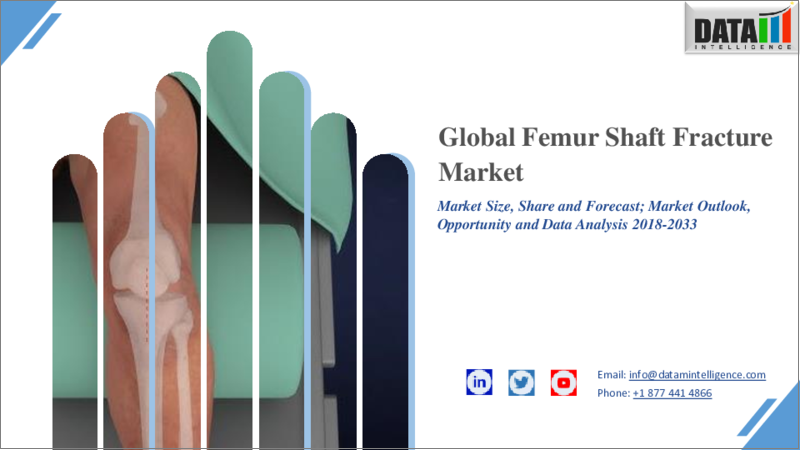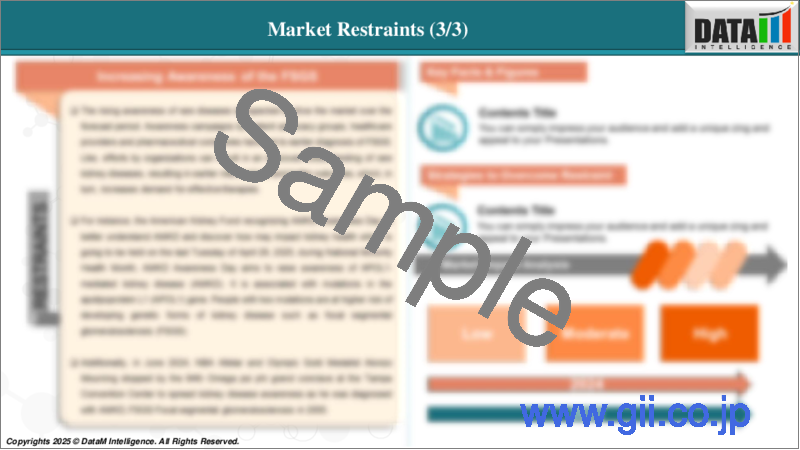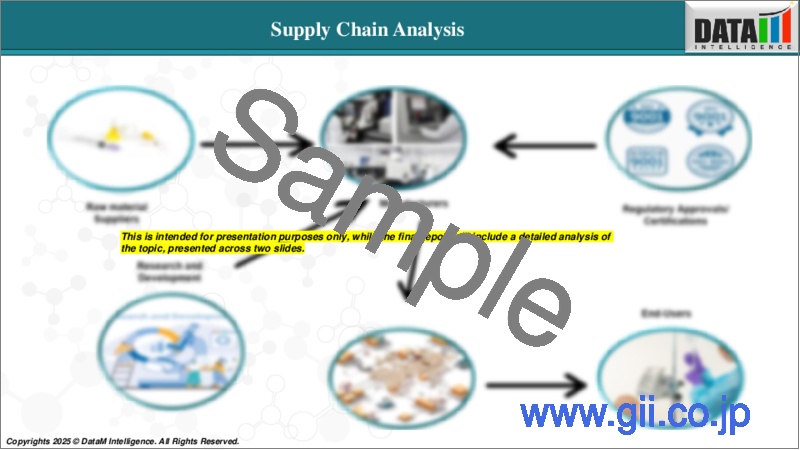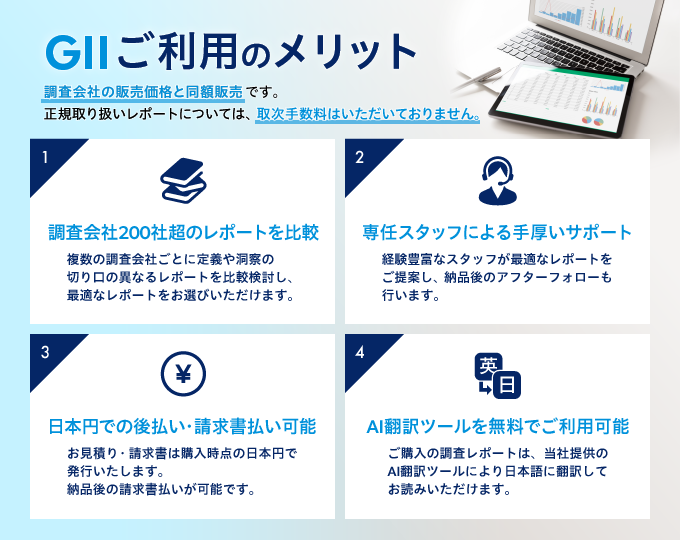|
|
市場調査レポート
商品コード
1643905
大腿骨骨幹部骨折の世界市場(2025年~2033年)Global Femur Shaft Fracture Market - 2025-2033 |
||||||
カスタマイズ可能
適宜更新あり
|
|||||||
| 大腿骨骨幹部骨折の世界市場(2025年~2033年) |
|
出版日: 2025年01月27日
発行: DataM Intelligence
ページ情報: 英文 176 Pages
納期: 即日から翌営業日
|
- 全表示
- 概要
- 目次
世界の大腿骨骨幹部骨折の市場規模は、2024年に6億3,624万米ドルに達し、2033年には15億9,905万米ドルに達すると予測され、予測期間2025年~2033年のCAGRは7.9%で成長する見込みです。
大腿骨骨幹部骨折とは、脚の骨の長さ方向に広がる骨折のことです。大腿骨の骨折は、それを生じさせる力によって大きく異なります。骨は正しく並ぶか(安定骨折)、ずれるか(転位骨折)します。皮膚は骨折部を取り囲むように無傷のまま残ることもあれば(閉鎖骨折)、骨が貫通することもあります(開放骨折)。
通常、大腿骨骨幹部の骨折は激しい不快感を引き起こします。負傷した足は体重を支えることができず、形が崩れ、もう片方の足よりも細く見えます。大腿骨骨幹部骨折市場の成長を促進する主な要因は、交通事故、高所からの落下、銃撃などの高エネルギー衝突事故の増加です。こうした事故の増加により大腿骨骨幹部骨折が発生し、これが市場成長の原動力となっています。
市場力学:
促進要因と抑制要因
交通事故の増加
交通事故の発生率の増加は、世界の大腿骨骨幹部骨折市場の成長における重要な要因になると予想されます。大腿骨骨幹部骨折市場の需要は、事故や怪我の増加に起因して増加しています。
例えば、世界保健機関(WHO)によると、毎年約119万人が交通事故によって負傷しています。世界の自動車保有台数の約60%が中低所得国であるにもかかわらず、世界の交通事故による負傷者の92%が中低所得国で発生しています。交通事故による死傷者は、ほとんどの国で国内総生産の3%を占めています。交通事故で負傷したり死亡したりする確率は、一般的に男性が女性の3倍です。
たとえば、国立衛生研究所によると、交通事故では両側または多発性の骨折部位が最もよく知られています。また、男性で最も多い骨折部位は大腿骨(28.2%)であるのに対し、女性では上腕骨骨折(20.8%)が最も多いことが確認されています。調査によると、プライマリケアで骨折と診断された患者のほぼ80%が、ギプス、装具、スリングによる治療を受けています。交通事故で負傷した患者の約16%が障害を経験します。整形外科的損傷は最も多いタイプの損傷であり、後遺障害の主な要因です。特に大腿骨骨折と脛骨開放骨折が多いです。交通事故も、発展途上国における骨折の主な原因です。
合併症と手術リスク
大腿骨骨幹部骨折の合併症や手術リスクなどの要因は、世界の大腿骨骨幹部骨折市場の妨げになると予想されます。最も深刻なリスクの一つは、特に外科的介入を必要とする状況における感染の可能性です。骨が皮膚を突き破って発生する開放骨折は感染症にかかりやすく、深刻な骨感染症である骨髄炎に進行する可能性があります。外科的固定に使用されるプレートやスクリューのような異物は、このリスクを高める可能性があります。感染症以外にも、骨折が適切に修復されなかったり、不適切な位置で治癒したりすることで起こる非結合や癒合不全などの問題もあります。このような問題により、回復に時間がかかったり、処置の回数が増えたりして、患者の転帰に影響を与え、ヘルスケア費用が増加する可能性があります。このような合併症や手術リスクは、世界の大腿骨骨幹部骨折市場を妨げる可能性があります。
目次
第1章 調査手法と調査範囲
第2章 定義と概要
第3章 エグゼクティブサマリー
第4章 市場力学
- 影響要因
- 促進要因
- 交通事故の増加
- 抑制要因
- 合併症と手術のリスク
- 機会
- 影響分析
第5章 産業分析
- ポーターのファイブフォース分析
- サプライチェーン分析
- 価格分析
- 規制分析
- 償還分析
- 特許分析
- SWOT分析
- DMIの見解
第6章 タイプ別
- Type1の骨折
- Type2の骨折
第7章 使用材料別
- チタン
- ステンレス鋼
- 生体吸収性材料
- その他
第8章 エンドユーザー別
- 病院
- 専門医/整形外科クリニック
- その他
第9章 地域別
- 北米
- 米国
- カナダ
- メキシコ
- 欧州
- ドイツ
- 英国
- フランス
- スペイン
- イタリア
- その他欧州
- 南米
- ブラジル
- アルゼンチン
- その他南米
- アジア太平洋
- 中国
- インド
- 日本
- 韓国
- その他アジア太平洋
- 中東・アフリカ
第10章 競合情勢
- 競合シナリオ
- 市況・シェア分析
- M&A分析
第11章 企業プロファイル
- DePuy Synthes
- 会社概要
- 製品ポートフォリオと概要
- 財務概要
- 主な発展
- Stryker
- Zimmer Biomet
- B. Braun SE
- Smith+Nephew
- Orthofix Medical Inc.
- Orthopaedic Implant Company
- Wright Medical Group
- Advanced Orthopaedic Solutions
- Aysam Orthopaedics & Medical Devices
第12章 付録
The Global Femur Shaft Fracture Market reached US$ 636.24 Million in 2024 and is expected to reach US$ 1599.05 Million by 2033, growing at a CAGR of 7.9% during the forecast period 2025-2033.
A femur shaft fracture is a break that spans along the length of the leg bone. Femur breaks vary greatly depending on the force that produces them. Bones will either line up properly (stable fracture) or be out of alignment (displaced fracture). The skin can remain intact surrounding the fracture (closed fracture), or it can be pierced by the bone (open fracture).
Typically, a fracturing of the femoral shaft causes severe discomfort. The injured limb would be unable to bear weight, making it appear misshapen, and thinner than the other leg. The major drivers driving the Femur shaft fracture market growth are the increased incidents of high-energy collisions, including road accidents, falling from high altitudes, and gunshots. The rising prevalence of these accidents leads to femur shaft fractures, which drives market growth.
Executive Summary
Market Dynamics: Drivers & Restraints
Increasing incidence of road accidents
The increasing incidence of road accidents is expected to be a significant factor in the growth of the global femur shaft fracture market. The demand for femur shaft fractures is increasing owing to the increasing number of accidents and injuries.
For instance, according to the World Health Organization, Approximately 1.19 million people get injured each year as a result of road traffic crashes. 92% of the world's injuries on the roads occur in low- and middle-income countries, even though these countries have around 60% of the world's vehicles. Road traffic crashes cost most countries 3% of their gross domestic product. Males are typically 3 times more likely to be injured or killed in road crashes than females.
For instance, according to the National Institute of Health, in road accidents, bilateral or multiple were the most commonly known sites of fractures. It is also observed that the most commonly fractured bone among males was the femur (28.2%) while a humerus fracture was the most common among females (20.8%). According to research, it is found that almost 80% of patients diagnosed with a fracture in primary care would be treated by installing casts, braces, or slings. Around 16% of patients who are injured in traffic accidents will experience disability. Orthopedic injuries are the most common type of injury and are the main factor in permanent disability. Injuries to the musculoskeletal system are the leading cause of disability in KLL patients, especially femur fractures and open fractures of the tibia. Traffic accidents are also the leading cause of most fracture cases in developing countries.
Complications and Surgical Risks
Factors such as complications and surgical risks for femur shaft fracture are expected to hamper the global femur shaft fracture market. One of the most serious risks is the possibility of infection, especially in situations requiring surgical intervention. Open fractures, which occur when the bone breaks through the skin, are more vulnerable to infections that can progress to osteomyelitis, a serious bone infection. Foreign materials, like plates and screws used in surgical fixation, can increase this risk. In addition to infection, other problems include nonunion or malunion of the fracture, which occurs when the bone fails to repair properly or heals in an improper position. These issues might cause longer recovery times and more procedures, affecting patient outcomes and increasing healthcare expenses. These complications and surgical risks may hamper the global femur shaft fracture market.
For more details on this report - Request for Sample
Segment Analysis
The Global femur shaft fracture Market is segmented based on Method, Type, Mode of Delivery, End-User, And Region.
Type 2 fracture segment is expected to dominate the global femur shaft fracture market share
Type 2 fractures, which often occur from high-impact trauma such as motor vehicle collisions or severe falls, are more widespread in modern society. The growing prevalence of road traffic accidents and the associated injuries significantly contribute to the demand for appropriate treatment alternatives. For instance, road traffic crashes affect around 1.3 million people each year, with millions more suffering non-fatal injuries such as femur shaft fractures. This concerning trend emphasizes the need for enhanced medical solutions, establishing Type 2 fractures as a critical priority area for industry growth and innovation.
Furthermore, the intricacy and severity of Type 2 fractures frequently necessitate surgical intervention, increasing the demand for specialized fixation devices and surgical methods. Advances in orthopedic surgery, notably less invasive treatments, and new implant designs, are tailored precisely to the needs of patients with Type 2 fractures. These advancements not only improve surgical outcomes but also shorten recuperation times, making them more appealing options for both healthcare practitioners and patients. As hospitals and clinics implement these new treatments, the Type 2 fracture category is expected to have a significant market share increase.
Geographical Analysis
North America is expected to hold a significant position in the global femur shaft fracture market share
North America is expected to hold a major portion of the global femur shaft fracture market due to a number of variables that influence market dynamics. One of the key reasons for this dominance is the region's advanced healthcare infrastructure, which allows for the rapid adoption of new medical technologies and treatment methods. The United States and Canada, in particular, have long-standing hospitals and specialist orthopedic clinics outfitted with advanced surgical technology and highly trained people. This robust infrastructure facilitates fast and effective treatment of femur shaft fractures, resulting in market growth.
Additionally, the growing incidence of high-energy trauma, notably from road traffic accidents, contributes significantly to the prevalence of femur shaft fractures in North America. For instance, according to The Ohio State University, 6 million people in the United States break a bone each year. Fractures account for 16% of all musculoskeletal injuries in the U.S. annually. More than 40% of fractures occur at home (22.5% inside and 19.1% outside). Approximately 887,679 hospitalizations result each year from fractures. For instance, according to HealthInAging.org, Up to 300,000 older adults are prone to fractures each year. Ninety percent of the time a fall causes these fractures. One in four men and one in two women over age 50 will break a bone due to osteoporosis. This disease makes bones fragile. The increased frequency of such accidents and the rising number of osteoporosis in North America need appropriate treatment options for femur shaft fractures, leading to an increase in demand for femur shaft fracture equipment and surgical procedures.
Asia Pacific is growing at the fastest pace in the global femur shaft fracture market
The Asia Pacific region is expected to expand the quickest in the global femur shaft fracture market, led by a convergence of demographic, economic, and healthcare advancements. One of the key causes driving this rapid expansion is the quickly growing population in nations such as India and China. This growing population not only increases the likelihood of traffic accidents and sports injuries, which are prominent causes of femur shaft fractures, but it also needs enhanced healthcare infrastructure and services to effectively handle these injuries. As urbanization accelerates, more people are exposed to high-energy trauma, driving up the demand for better treatment options.
Competitive Landscape
The major global players in the global femur shaft fracture market are DePuy Synthes, Stryker, Zimmer Biomet, B. Braun SE, Smith+Nephew, Orthofix Medical Inc., Orthopaedic Implant Company, Wright Medical Group, Advanced Orthopaedic Solutions, Aysam Orthopaedics & Medical Devices among others.
Emerging Players
PBC BioMed, Conventus Flower Orthopedics, and Starr Frame among others
Metrics Details
CAGR 7.9%
Market Size Available for Years 2018-2033
Estimation Forecast Period 2025-2033
Revenue Units Value (US$ Mn)
Segments Covered Type Type 1 Fracture, Type 2 Fracture
Material Used Titanium, Stainless Steel, Bioresorbable Materials, Others
End-User Hospitals, Specialty/Orthopedic Clinics, Others
Regions Covered North America, Europe, Asia-Pacific, South America, and Middle East & Africa
Why Purchase the Report?
- Pipeline & Innovations: Reviews ongoing clinical trials, product pipelines, and forecasts upcoming advancements in medical devices and pharmaceuticals.
- Product Performance & Market Positioning: Analyzes product performance, market positioning, and growth potential to optimize strategies.
- Real-World Evidence: Integrates patient feedback and data into product development for improved outcomes.
- Physician Preferences & Health System Impact: Examines healthcare provider behaviors and the impact of health system mergers on adoption strategies.
- Market Updates & Industry Changes: Covers recent regulatory changes, new policies, and emerging technologies.
- Competitive Strategies: Analyzes competitor strategies, market share, and emerging players.
- Pricing & Market Access: Reviews pricing models, reimbursement trends, and market access strategies.
- Market Entry & Expansion: Identifies optimal strategies for entering new markets and partnerships.
- Regional Growth & Investment: Highlights high-growth regions and investment opportunities.
- Supply Chain Optimization: Assesses supply chain risks and distribution strategies for efficient product delivery.
- Sustainability & Regulatory Impact: Focuses on eco-friendly practices and evolving regulations in healthcare.
- Post-market Surveillance: Uses post-market data to enhance product safety and access.
- Pharmacoeconomics & Value-Based Pricing: Analyzes the shift to value-based pricing and data-driven decision-making in R&D.
The global femur shaft fracture market report delivers a detailed analysis with 65+ key tables, more than 55 visually impactful figures, and 200 pages of expert insights, providing a complete view of the market landscape.
Target Audience 2024
- Manufacturers: Pharmaceutical, Medical Device, Biotech Companies, Contract Manufacturers, Distributors, Hospitals.
- Regulatory & Policy: Compliance Officers, Government, Health Economists, Market Access Specialists.
- Technology & Innovation: AI/Robotics Providers, R&D Professionals, Clinical Trial Managers, Pharmacovigilance Experts.
- Investors: Healthcare Investors, Venture Fund Investors, Pharma Marketing & Sales.
- Consulting & Advisory: Healthcare Consultants, Industry Associations, Analysts.
- Supply Chain: Distribution and Supply Chain Managers.
- Consumers & Advocacy: Patients, Advocacy Groups, Insurance Companies.
- Academic & Research: Academic Institutions.
Table of Contents
1. Methodology and Scope
- 1.1. Research Methodology
- 1.2. Research Objective and Scope of the Report
2. Definition and Overview
3. Executive Summary
- 3.1. Snippet by Type
- 3.2. Snippet by Material Used
- 3.3. Snippet by End-User
- 3.4. Snippet by Region
4. Dynamics
- 4.1. Impacting Factors
- 4.1.1. Drivers
- 4.1.2. Increasing Incidence of Road Accidents
- 4.1.3. Restraints
- 4.1.4. Complications and Surgical Risks
- 4.1.5. Opportunity
- 4.1.6. Impact Analysis
5. Industry Analysis
- 5.1. Porter's Five Force Analysis
- 5.2. Supply Chain Analysis
- 5.3. Pricing Analysis
- 5.4. Regulatory Analysis
- 5.5. Reimbursement Analysis
- 5.6. Patent Analysis
- 5.7. SWOT Analysis
- 5.8. DMI Opinion
6. By Type
- 6.1. Introduction
- 6.1.1. Market Size Analysis and Y-o-Y Growth Analysis (%), By Type
- 6.1.2. Market Attractiveness Index, By Type
- 6.2. Type 1 Fracture*
- 6.2.1. Introduction
- 6.2.2. Market Size Analysis and Y-o-Y Growth Analysis (%)
- 6.3. Type 2 Fracture
7. By Material Used
- 7.1. Introduction
- 7.1.1. Market Size Analysis and Y-o-Y Growth Analysis (%), By Material Used
- 7.1.2. Market Attractiveness Index, By Material Used
- 7.2. Titanium*
- 7.2.1. Introduction
- 7.2.2. Market Size Analysis and Y-o-Y Growth Analysis (%)
- 7.3. Stainless Steel
- 7.4. Bioresorbable Materials
- 7.5. Others
8. By End-User
- 8.1. Introduction
- 8.1.1. Market Size Analysis and Y-o-Y Growth Analysis (%), By End-User
- 8.1.2. Market Attractiveness Index, By End-User
- 8.2. Hospitals*
- 8.2.1. Introduction
- 8.2.2. Market Size Analysis and Y-o-Y Growth Analysis (%)
- 8.3. Specialty/Orthopedic Clinics
- 8.4. Others
9. By Region
- 9.1. Introduction
- 9.1.1. Market Size Analysis and Y-o-Y Growth Analysis (%), By Region
- 9.1.2. Market Attractiveness Index, By Region
- 9.2. North America
- 9.2.1. Introduction
- 9.2.2. Key Region-Specific Dynamics
- 9.2.3. Market Size Analysis and Y-o-Y Growth Analysis (%), By Type
- 9.2.4. Market Size Analysis and Y-o-Y Growth Analysis (%), By Material Used
- 9.2.5. Market Size Analysis and Y-o-Y Growth Analysis (%), By End-User
- 9.2.6. Market Size Analysis and Y-o-Y Growth Analysis (%), By Country
- 9.2.6.1. U.S.
- 9.2.6.2. Canada
- 9.2.6.3. Mexico
- 9.3. Europe
- 9.3.1. Introduction
- 9.3.2. Key Region-Specific Dynamics
- 9.3.3. Market Size Analysis and Y-o-Y Growth Analysis (%), By Type
- 9.3.4. Market Size Analysis and Y-o-Y Growth Analysis (%), By Material Used
- 9.3.5. Market Size Analysis and Y-o-Y Growth Analysis (%), By End-User
- 9.3.6. Market Size Analysis and Y-o-Y Growth Analysis (%), By Country
- 9.3.6.1. Germany
- 9.3.6.2. U.K.
- 9.3.6.3. France
- 9.3.6.4. Spain
- 9.3.6.5. Italy
- 9.3.6.6. Rest of Europe
- 9.4. South America
- 9.4.1. Introduction
- 9.4.2. Key Region-Specific Dynamics
- 9.4.3. Market Size Analysis and Y-o-Y Growth Analysis (%), By Type
- 9.4.4. Market Size Analysis and Y-o-Y Growth Analysis (%), By Material Used
- 9.4.5. Market Size Analysis and Y-o-Y Growth Analysis (%), By End-User
- 9.4.6. Market Size Analysis and Y-o-Y Growth Analysis (%), By Country
- 9.4.6.1. Brazil
- 9.4.6.2. Argentina
- 9.4.6.3. Rest of South America
- 9.5. Asia-Pacific
- 9.5.1. Introduction
- 9.5.2. Key Region-Specific Dynamics
- 9.5.3. Market Size Analysis and Y-o-Y Growth Analysis (%), By Type
- 9.5.4. Market Size Analysis and Y-o-Y Growth Analysis (%), By Material Used
- 9.5.5. Market Size Analysis and Y-o-Y Growth Analysis (%), By End-User
- 9.5.6. Market Size Analysis and Y-o-Y Growth Analysis (%), By Country
- 9.5.6.1. China
- 9.5.6.2. India
- 9.5.6.3. Japan
- 9.5.6.4. South Korea
- 9.5.6.5. Rest of Asia-Pacific
- 9.6. Middle East and Africa
- 9.6.1. Introduction
- 9.6.2. Key Region-Specific Dynamics
- 9.6.3. Market Size Analysis and Y-o-Y Growth Analysis (%), By Type
- 9.6.4. Market Size Analysis and Y-o-Y Growth Analysis (%), By Material Used
- 9.6.5. Market Size Analysis and Y-o-Y Growth Analysis (%), By End-User
10. Competitive Landscape
- 10.1. Competitive Scenario
- 10.2. Market Positioning/Share Analysis
- 10.3. Mergers and Acquisitions Analysis
11. Company Profiles
- 11.1. DePuy Synthes*
- 11.1.1. Company Overview
- 11.1.2. Product Portfolio and Description
- 11.1.3. Financial Overview
- 11.1.4. Key Developments
- 11.2. Stryker
- 11.3. Zimmer Biomet
- 11.4. B. Braun SE
- 11.5. Smith+Nephew
- 11.6. Orthofix Medical Inc.
- 11.7. Orthopaedic Implant Company
- 11.8. Wright Medical Group
- 11.9. Advanced Orthopaedic Solutions
- 11.10. Aysam Orthopaedics & Medical Devices
LIST NOT EXHAUSTIVE
12. Appendix
- 12.1. About Us and Services
- 12.2. Contact Us






